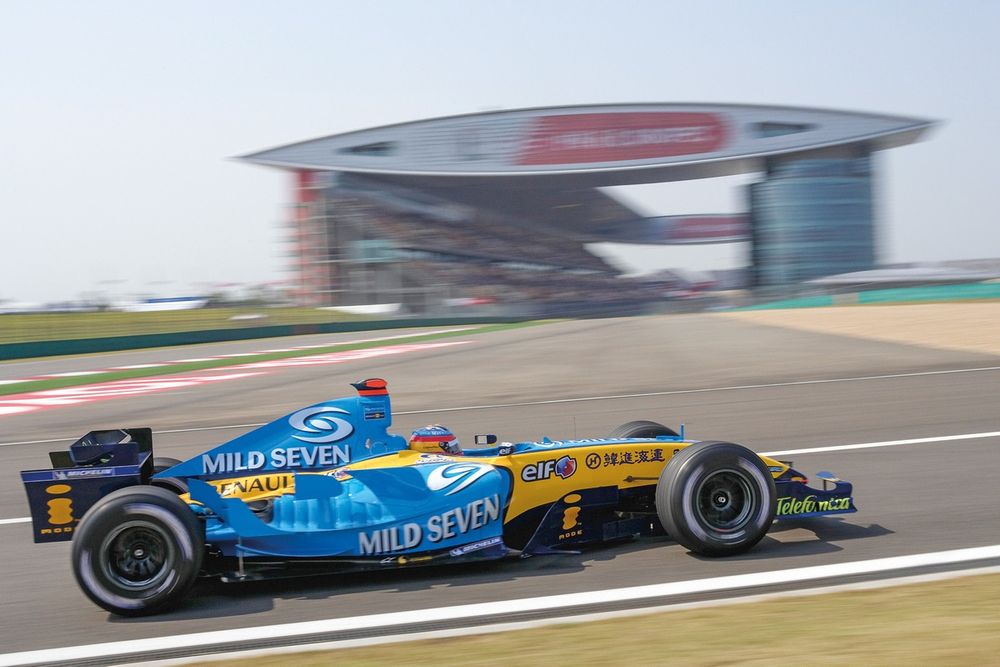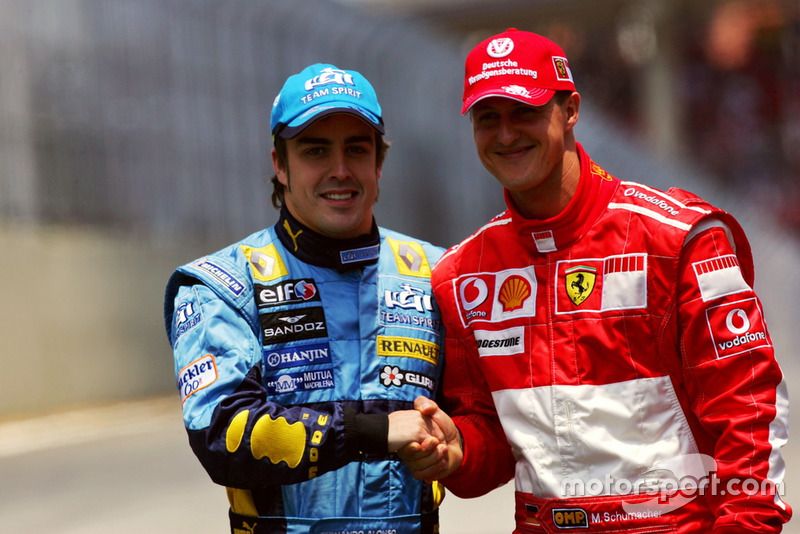20 years ago, Fernando Alonso was engaged in a thrilling championship run-in with Kimi Raikkonen and a young tyre engineer with a bright future was about to join Alonso’s Renault team.
Ayao Komatsu had got his F1 break working for BAR-Honda’s test team in a high-spending era where leading manufacturer backed organisations had two windtunnels tunning continuously and fully manned test squads operating in parallel with the race team throughout the season. That involved him working with the likes of Jenson Button, Takuma Sato and test driver Anthony Davidson.
In 2005 BAR-Honda’s upwards trajectory was interrupted by a scandal involving a secondary fuel tank which caused the team to be disqualified from the San Marino Grand Prix banned for two further races. At the end of the season Komatsu changed up, moving to Alonso’s Renault team and working with the newly crowned world champion himself.

Fernando Alonso, Renault R25
Photo by: Rainer Schlegelmilch / Getty Images
Button’s championship – indeed, his maiden grand prix victory – lay in the future at that point. For Komatsu, working with an established great was a formative experience.
“Back then, I was a tyre engineer on the test team,” Komatsu told reporters during the 2025 Dutch GP weekend.
“But the year before, I was at BAR Honda doing the same job, working with people like Jenson Button, mainly. Anthony [Davidson] was there as well.
“When I came to Renault in 2006, of course we did the initial tyre selection with the test drivers. But final sign-off, quite often, we did it with race drivers, especially Fernando.
“He’s just another level. Completely another level. Knowing that if you give him this tyre and say, ‘OK, we need you to do, let’s say, an 18-lap stint. The last three laps, I want to be able to go at this pace – but just completely use up the tyre by the in-lap.’
“Jenson couldn’t do that. Miles from it. He really couldn’t. That was when I saw there was a limit, even for a Formula 1 driver… Fernando, I don’t know how he does it.
“He knows how much is left on the tyre, so he will drive it at a certain level – and the last three laps, he just goes bang, bang, bang. In-lap sector two – the tyre is dead.
“It was just totally another level. And I thought, ‘Wow, this is a world champion.’ That was a huge eye-opener for me. It was a pleasure to work with him, it was amazing.”
Finding grip when others can’t

Fernando Alonso, Renault R26
Photo by: Gareth Bumstead
Beyond his ability to gauge the spare capacity of the rubber in dry conditions, Alonso also excelled in identifying the precise levels of available grip during the transition from wet to dry and back again. Komatsu highlighted the 2006 Chinese GP – ultimately won by Michael Schumacher in a Bridgestone-shod Ferrari – as an example of Alonso’s confidence on Renault’s Michelin rubber.
“Shanghai race, he [Alonso] made a call to come in for slicks,” said Komatsu. “We all thought it was too early. But he can make it work.
“He’s the sort of driver who’s got confidence in the condition and tyres – straight out of pitlane, he can push the tyre to get it started. That was amazing.
“But then, we pitted his team-mate [Giancarlo Fisichella], I can’t remember if it was one lap later, two laps later, much better conditions. But he [Fisichella] was just a bit more tentative out of pitlane.
“Then just couldn’t get on the positive spiral. He lost so much time.”

Fernando Alonso, Michael Schumacher
Photo by: Sutton Images
This is a slightly rose-tinted recollection since by that point Alonso was in recovery mode after Renault had made the call to put new intermediates on the front axle only during Fernando’s first stop. That and a sticking wheel nut when he came in for slicks put paid to Alonso’s chance of victory.
Fisichella was leading and stopped six laps later – but lost it to Schumacher by being too tentative into Turn 1 on his out-lap. By the end of the race, Alonso had made up a 10-second deficit and passed his team-mate for second place.
Alonso’s capacity to read a race – not just what is happening immediately around him, but elsewhere – came into sharp focus during the Canadian Grand Prix, where Fernando had a 25-second lead on Raikkonen in the closing stages when Jacques Villeneuve clattered into the ‘Wall of Champions’ at the exit of Turn 13.
“He just told us, ‘Oh, get ready, it’s going to be a Safety Car,’” said Komatsu.
“We had no idea how he managed to know that. And he told us later, he was leading the race, he got bored, and he was watching the race on the big screens.
“He saw this massive shunt and he knew we hadn’t seen it. So, he just told us. “I mean, how much spare capacity have you got left?”
In this article
Be the first to know and subscribe for real-time news email updates on these topics

